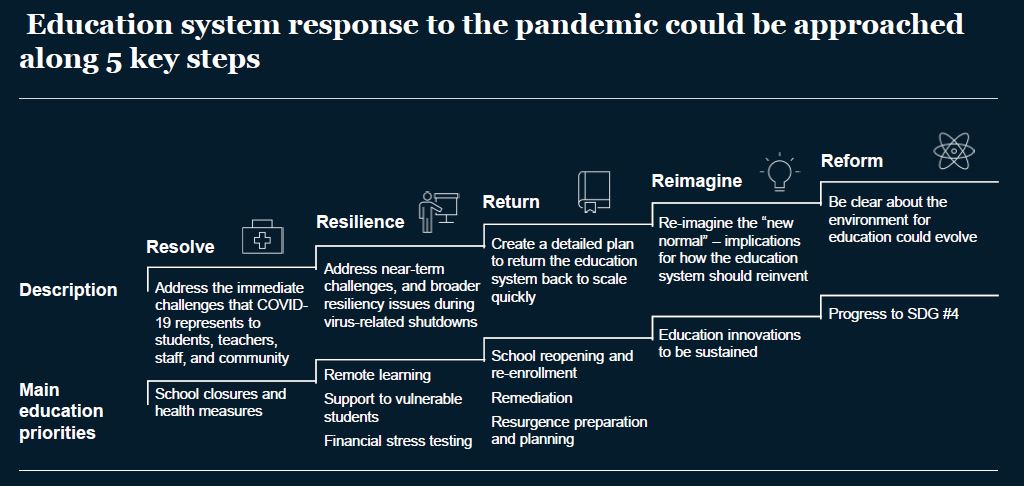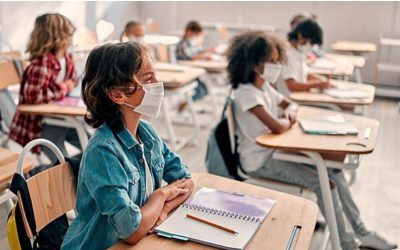Scenario planning for school systems in response to Covid-19
17 Apr 2020 | Policy-makers
How should education systems and schools plan for teaching and learning in the current COVID-19 crisis? This question underpinned a webinar, organized by McKinsey on the 16th of April 2020.
Prof. dr. Melanie Ehren (m.c.m.ehren@vu.nl) and Alissa Postpischil
17-04-2020


During the webinar, McKinsey presented a five-step model of how education systems can move through the crisis which they need to plan for, particularly to support students in vulnerable situations:

According to McKinsey, most countries are now in the second phase where schools are offering online teaching and are organizing support for vulnerable students.
Resilience: support of students in vulnerable situations and keeping up momentum for online learning
An example of how to organize support for students in vulnerable situations was given by a school principal from New York. He explained how his school board prepared an excel worksheet where each student was classified as low, medium, high risk based on data about:
- Housing insecurity
- Special Education Needs status
- Mandated counselling
- Academic risk – especially failing English and/or math
- Socio-emotional risk: suspensions, behaviour, history of significant emotional needs
- Family financial status
- Other siblings who are similarly situated – so evidence of household risk
The excel was sent to schools who updated the classification with their insight knowledge about actual risk of students. The risk classification was then used to develop and target additional support to these learners, according to risk category, such as scheduling individual calls, home visits, text messages to parents etc.
Low risk students may become high risk
Principals in the webinar stated that this excel file needs to be a ‘live document’ which needs to be regularly updated as children who are considered ‘low risk’ at present may become high risk in the near future when lock-down measures continue and the situation at home changes and students experience increasing stress levels.
Keeping up momentum
A concern raised, particularly when the current school lock down continues is also how to sustain momentum for online learning, particularly in terms of student attendance and engagement with online learning and teacher motivation and workload.
Planning for return
As schools will re-open again at some point, countries now need to prepare for the third phase of ‘return’, according to McKinsey. Planning needs to focus on how to remediate potential learning loss, allowing for flexibility in in-school and online learning, but also thinking about the current good practices that should be sustained.
Assessment and remediation and revised scope and sequence
Planning for remediation requires a good understanding of the actual learning of students during school lock down. Principals in the call expressed their concern about now knowing what students are currently doing at home, how well they are mastering academic content, their well-being and development of socio-emotional skills. They argued for the development of assessments to provide such information to be able to plan the scope and sequence of the curriculum for when schools re-open. Examples that were given referred to portfolio assignments to assess the standards that students are working towards. These are currently being developed by New York in the absence of the regents exams which measure student achievement in high school-level courses.
Flexibility in arrangements
Planning also needs to take into account that some parents will be anxious to send their children back to school and won’t do so initially. There is a need for flexibility in offering both off and online learning and assessment initially and this also needs to be planned for.
Sustaining good practice:
Principals also argued that current planning needs to ensure that all the current innovative work in schools will be sustained when schools re-open, making sure that we don’t go back to normal and lose some of the great practices that are currently being developed. Examples that were mentioned were to continue holding virtual online parent meetings to ensure a greater turn-out of parents who struggle to come to school.
See also information for:
Most recent blogs:
How LEARN! supports primary and secondary schools in mapping social-emotional functioning and well-being for the school scan of the National Education Program
Jun 28, 2021
Extra support, catch-up programmes, learning delays, these have now become common terms in...
Conference ‘Increasing educational opportunities in the wake of Covid-19’
Jun 21, 2021
Covid-19 has an enormous impact on education. This has led to an increased interest in how recent...
Educational opportunities in the wake of COVID-19: webinars now available on Youtube
Jun 17, 2021
On the 9th of June LEARN! and Educationlab organized an online conference about...
Homeschooling during the COVID-19 pandemic: Parental experiences, risk and resilience
Apr 1, 2021
Lockdown measures and school closures due to the COVID-19 pandemic meant that families with...
Catch-up and support programmes in primary and secondary education
Mar 1, 2021
The Ministry of Education, Culture and Science (OCW) provides funding in three application rounds...
Home education with adaptive practice software: gains instead of losses?
Jan 26, 2021
As schools all over Europe remain shuttered for the second time this winter because of the Covid...





